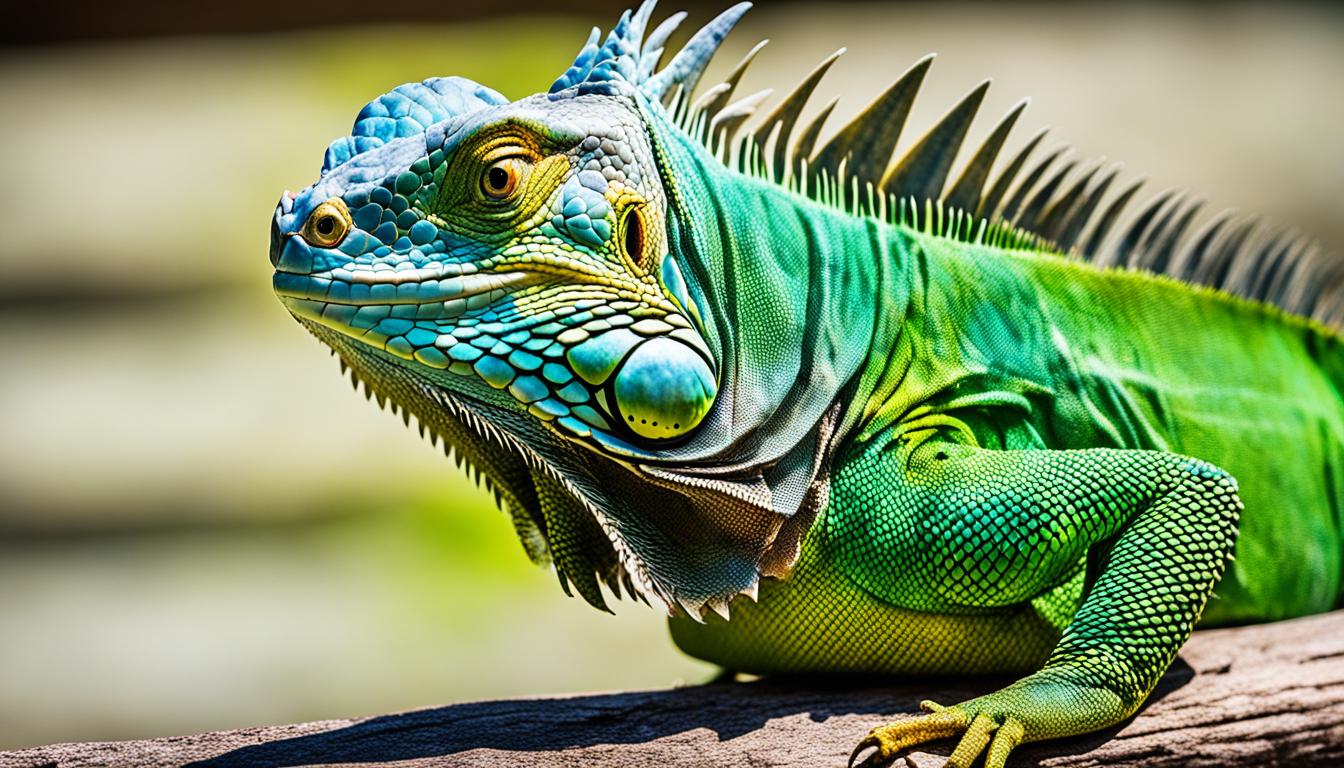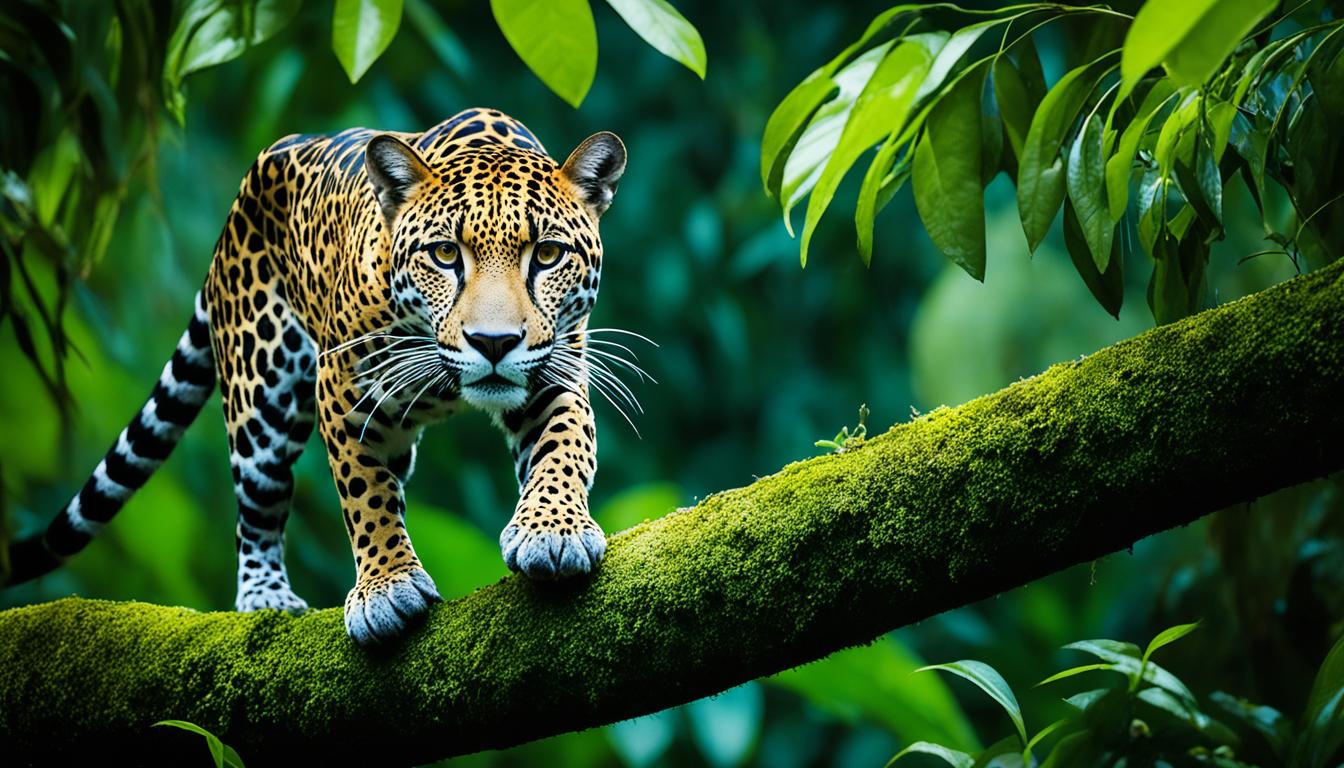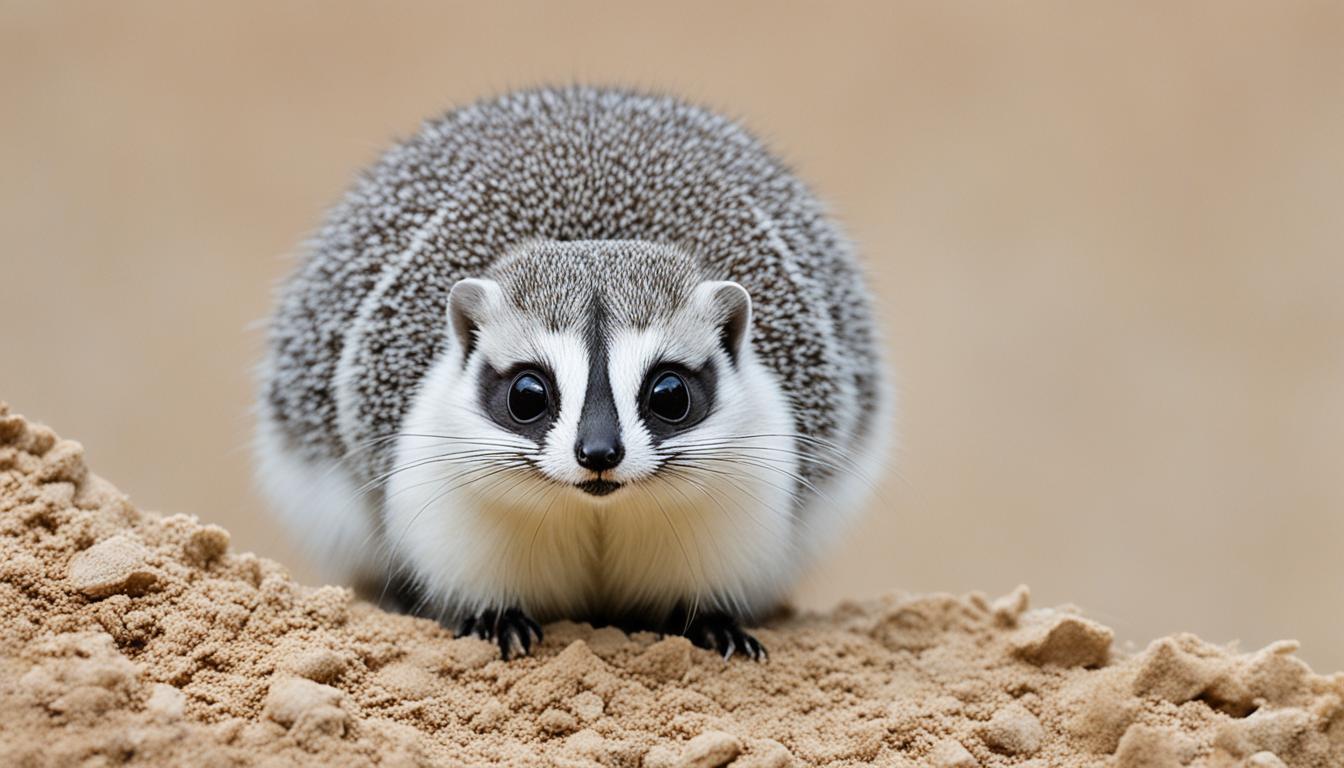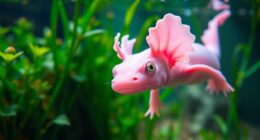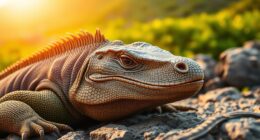Did you realize that green animals thrive in a variety of habitats worldwide, demonstrating nature’s marvels and providing impeccable camouflage? From tropical rainforests to temperate zones, these creatures enchant with their vivid green shades and intriguing adaptations. This article delves into 12 green animals from various corners of the globe, each possessing distinct characteristics and mesmerizing beauty.
Key Takeaways:
- Green animals can be found in different habitats worldwide, showcasing the diverse beauty of the natural world.
- They include birds, reptiles, insects, and amphibians, each with their own unique adaptations for survival.
- Many green animals are threatened due to habitat destruction and other human activities.
- Exploring the world of green animals highlights the incredible biodiversity on our planet.
- Appreciating and protecting these fascinating creatures is crucial for the preservation of our natural heritage.
Amazon Parrot
The Amazon parrot, known for its stunning green plumage, is a beloved bird species native to the lush rainforests of Central and South America, as well as the Caribbean. These vibrant and intelligent creatures belong to the genus Amazona, which comprises more than 30 species.
With their striking emerald feathers, Amazon parrots capture the hearts of bird enthusiasts around the world. Their radiant coloration acts as camouflage among the lush foliage of their natural habitat, allowing them to blend seamlessly into the tropical rainforests.
In addition to their beauty, Amazon parrots are renowned for their remarkable intelligence and ability to mimic human speech. Their playful and social nature makes them popular pets among bird lovers. However, the pet trade has posed significant threats to their survival.
“The Amazon parrots of tropical America are not just stunning companions; they are also important members of their ecosystems.”
Unfortunately, the Amazon parrots face numerous challenges. Habitat destruction, primarily due to deforestation, and the illegal pet trade have led to population declines in many Amazon parrot species. Their captivating plumage, combined with their friendly and engaging personalities, make them highly sought after by collectors and enthusiasts.
To protect these magnificent creatures and ensure their long-term survival, conservation efforts are paramount. Organizations and individuals are working tirelessly to restore and preserve their natural habitat, raise awareness about the illegal pet trade, and promote responsible ownership of Amazon parrots.
It is crucial to appreciate the beauty and significance of the Amazon parrot, not only as a bird of extraordinary splendor but also as an integral part of the diverse tapestry of tropical America’s ecosystem.
| Amazon Parrot Species | Native Regions |
|---|---|
| Red-lored Amazon | Central America, Mexico, and northern South America |
| Yellow-headed Amazon | Yucatán Peninsula, Mexico, and northern Central America |
| Blue-fronted Amazon | South America, including Brazil, Paraguay, and Argentina |
Eastern Green Mamba
The eastern green mamba is a highly venomous reptile with a mesmerizing green coloration. This species, scientifically known as Dendroaspis angusticeps, is native to East and Southern Africa and is primarily found living in trees. It is one of three green mamba species and can be spotted along the coasts of the Indian Ocean.
The eastern green mamba is known for its slender body, which can reach lengths of up to 8 feet, and its bright green scales that provide excellent camouflage in the forest canopies it inhabits. Its venom is highly potent, containing neurotoxins that can cause paralysis and, in some cases, death.

Characteristics of the Eastern Green Mamba:
| Species | Scientific Name | Habitat | Length |
|---|---|---|---|
| Eastern Green Mamba | Dendroaspis angusticeps | Tropical and subtropical forests | Up to 8 feet |
The eastern green mamba primarily feeds on small rodents, birds, and other reptiles. Its slender shape allows it to move swiftly through trees, enabling it to hunt and ambush prey with precision. Despite its potent venom, the eastern green mamba is generally docile and will only bite when threatened.
Did you know?
In tribal cultures of East and Southern Africa, the eastern green mamba is a revered creature that symbolizes powers of protection, transformation, and regeneration.
Encountering an eastern green mamba in the wild is a rare and thrilling experience for wildlife enthusiasts. However, due to deforestation and habitat loss, as well as illegal wildlife trade, the population of the eastern green mamba is currently facing significant threats. Conservation efforts are crucial to ensure the survival of this remarkable reptile.
Praying Mantis
A fascinating insect found in various tropical and temperate regions worldwide, the praying mantis is known for its distinctive triangular head and folded forearms that resemble a praying posture.
These green-colored carnivorous insects are remarkable ambush predators, blending seamlessly into their surroundings to capture unsuspecting prey. Their elongated bodies and spiky forelegs allow them to snatch insects with lightning speed.
The praying mantis exhibits unique behavior, including sexual cannibalism. After mating, the female mantis often consumes the male, a phenomenon that has fascinated scientists for years.

Praying Mantis in Tropical and Temperate Regions
Praying mantids can be found in a wide range of tropical and temperate regions across the globe, adapting to diverse ecosystems. In tropical zones, they thrive in rainforests, where their green coloration allows them to blend in with lush foliage.
In temperate regions, mantises can be spotted in gardens, meadows, and forests. They play a crucial role in controlling insect populations, making them valuable allies in natural pest control.
Praying Mantis Table
| Characteristics | Tropical Regions | Temperate Regions |
|---|---|---|
| Coloration | Vibrant green to camouflage in dense foliage | Muted green or brown to blend with their surroundings |
| Habitat | Rainforests, tropical grasslands | Gardens, meadows, forests |
| Prey | Various insects, including butterflies and moths | Insects, spiders, small vertebrates |
| Behavior | Aggressive hunters; sometimes engage in cannibalism | Patient ambush predators, blending with foliage |
Fun Fact
The praying mantis has binocular vision, allowing it to accurately judge the distance and size of its prey. This extraordinary vision helps it to strike with precision.
Emerald Tree Boa
The emerald tree boa is a fascinating reptile that can be found in the lush rainforests of South America. With its striking emerald green color, this snake species stands out amidst the rich biodiversity of its habitat. Growing up to 6 feet long, the emerald tree boa has adapted to life in the trees, where it spends the majority of its time wrapped around branches.
These boas are constrictors, using their powerful bodies to capture and kill their prey. Primarily feeding on small mammals, birds, lizards, and frogs, the emerald tree boa is an efficient hunter within its ecosystem. Its vibrant green coloration serves as a natural camouflage, allowing it to blend seamlessly with the surrounding foliage.

Due to habitat loss and illegal pet trade, the emerald tree boa population faces some challenges in the wild. Conservation efforts are crucial to protect these magnificent reptiles and preserve the delicate balance of South America’s rainforests.
Incredible Adaptations
The emerald tree boa possesses several remarkable adaptations that contribute to its survival in the rainforest. Its prehensile tail aids in climbing and gripping branches, providing stability while navigating its arboreal habitat. Additionally, the snake’s heat-sensing pits enable it to locate warm-blooded prey in the dark, ensuring successful hunts.
Comparing Emerald Tree Boas with Other Boa Constrictors
| Species | Distribution | Coloration | Size |
|---|---|---|---|
| Emerald Tree Boa | South America | Emerald Green | Up to 6 feet |
| Red-tailed Boa | Tropical Americas | Patterned with brown, red, and orange | Up to 10 feet |
| Common Boa | Central and South America | Variety of colors, including brown, gray, and orange | Up to 13 feet |
The emerald tree boa’s unique characteristics and vital role in its ecosystem make it a captivating reptile to study and admire. Its vibrant green color and arboreal lifestyle exemplify the wonders of South America’s rainforests, showcasing the incredible diversity of reptile species found in this region.
Male Eclectus Parrot
Male eclectus parrots are known for their vibrant green plumage, creating a striking appearance in the avian world. In stark contrast, the females of this bird species display a stunning red coloration, making them distinct from their male counterparts.
These beautiful parrots can be found in the lush rainforests of New Guinea, the Solomon Islands, and the northern tip of Australia. Their natural habitats provide them with ample food sources, including a wide variety of fruits, seeds, and nuts.
Eclectus parrots are highly valued not only for their stunning appearance but also for their engaging personalities. They are known to be friendly, social, and intelligent birds, making them popular pets among bird enthusiasts.
One of the fascinating abilities of the male eclectus parrot is its talent for mimicking human language. These birds have the potential to learn and repeat words and phrases, captivating their human companions with their mimicry skills.

Whether in their natural habitats or as cherished pets, male eclectus parrots continue to captivate bird enthusiasts with their remarkable beauty and unique traits.
Resplendent Quetzal
The resplendent quetzal is a striking bird found in the rainforests of Central America. Its body is covered with bright green iridescent feathers, creating a mesmerizing display of color. This beautiful bird is famous for its long, vibrant tail feathers, which can reach up to three feet in length. Male quetzals have a resplendent plumage, with shades of emerald green, while females have more muted colors.
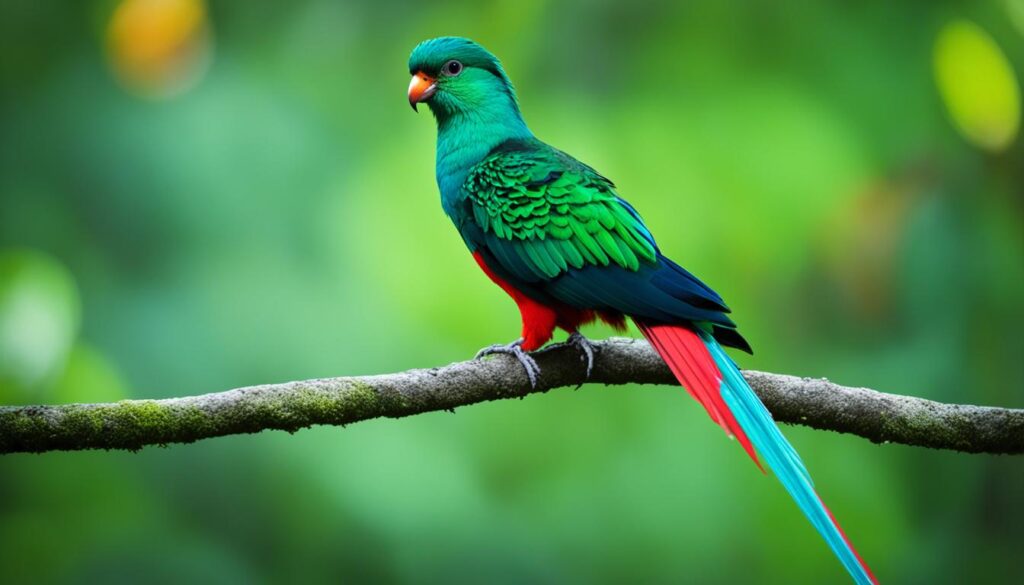
Cultural Significance
Quetzals hold cultural significance in Mesoamerican cultures, including the Mayas and Aztecs. These ancient civilizations revered the bird for its beauty and association with precious treasures. The quetzal’s feathers were highly valued and used in ceremonial headdresses and regal attire. Due to its cultural significance, the quetzal is the national bird of Guatemala and a symbol of freedom and wealth.
Feeding Habits
Quetzals are frugivorous, meaning they primarily feed on fruits. Their diet consists of a variety of fruits, including figs, wild avocadoes, and berries. Their beaks are specially adapted for consuming these fruits, allowing them to easily extract the edible parts while discarding the seeds. They play an essential role in the dispersal of seeds, contributing to the regeneration of the rainforest.
Conservation Status
Due to habitat loss and deforestation, the resplendent quetzal is considered near threatened by the International Union for Conservation of Nature (IUCN). The destruction of its rainforest habitat deprives these birds of nesting sites and food sources. Conservation efforts are crucial to protect this iconic species and ensure its continued existence in the wild.
American Green Tree Frog
The American green tree frog is a small, bright green amphibian native to the southeastern part of the United States. Known for its vibrant coloration, this frog is a delightful sight in its natural habitat. However, the American green tree frog is facing challenges that threaten its survival.
This amphibian species is renowned for its unique ability to climb vertical surfaces using adhesive toe pads. This adaptation allows it to navigate trees and vegetation with ease, making it a true arboreal marvel. The American green tree frog measures approximately 1.5 to 2.5 inches in length, with females being slightly larger than males.
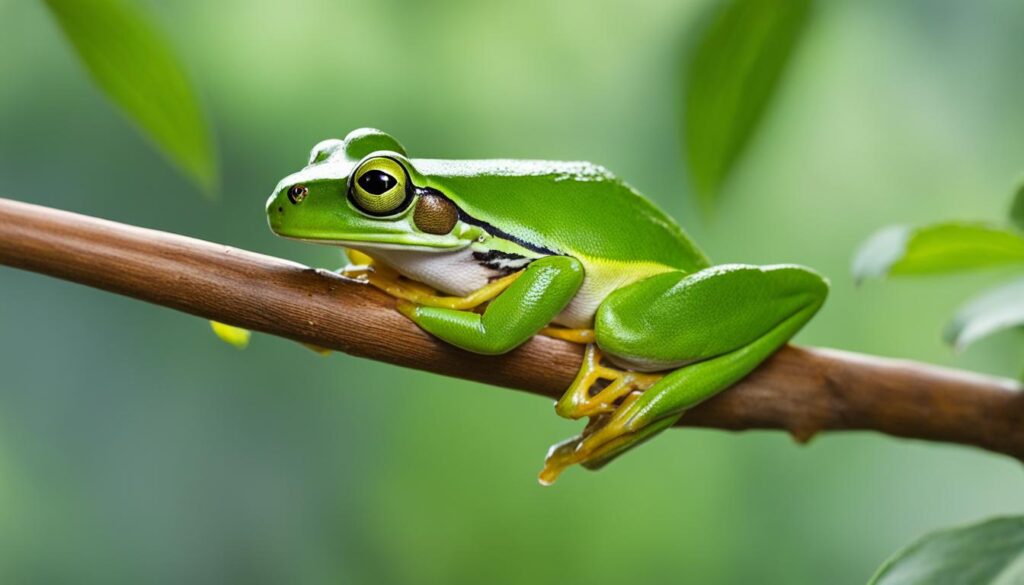
Declining Numbers and Threats
Unfortunately, the American green tree frog population is experiencing a decline due to various factors, including habitat loss and fragmentation caused by urbanization. As cities expand and natural habitats are replaced by concrete, these frogs lose their homes and vital resources.
Moreover, wildfires pose a significant threat to the survival of American green tree frogs. The intense heat and destruction caused by wildfires can devastate the frog’s habitat, disrupting its natural ecosystem and reducing its chances of survival.
Conservation Efforts
Efforts are being made to conserve the American green tree frog and protect its habitat. Conservation organizations work to raise awareness about the importance of preserving the natural habitats that these frogs rely on. They also advocate for sustainable development practices that take into account the needs of wildlife.
Protecting the American green tree frog and its habitat is crucial for maintaining the biodiversity and ecological balance of the southeastern United States. By preserving these unique amphibians, we can ensure a vibrant and healthy natural environment for future generations to enjoy.
The Importance of Green Amphibians
Green amphibians, like the American green tree frog, play an essential role in their ecosystems. They serve as indicators of environmental health and contribute to the overall balance of their habitats. Additionally, their unique coloration aids in camouflage and protection from predators.
By appreciating and protecting green amphibians, we can contribute to the preservation of biodiversity and the United States’ natural heritage. These fascinating creatures remind us of the incredible diversity and beauty of the animal kingdom.
Leaf Insect
Leaf insects, also known as “walking leaves,” are fascinating insects that have perfected the art of camouflage. They have evolved to mimic the appearance of green tree leaves, allowing them to blend seamlessly into their surroundings and become almost invisible to predators. These remarkable creatures can be found in South and Southeast Asia, as well as Australia.
What sets leaf insects apart is their ability to mimic not only the color but also the shape and texture of leaves. Their bodies are elongated and flattened, resembling the veins and patterns found on real leaves. Some species even have fringed edges that imitate the ragged appearance of wind-blown leaves. This incredible mimicry allows leaf insects to hide in plain sight, making it difficult for predators to distinguish them from actual foliage.
Leaf insects are masters of disguise and possess a range of adaptations that enhance their camouflage. They have slow deliberate movements that imitate the swaying of leaves in the breeze, further enhancing their authenticity. Additionally, many leaf insects have evolved a behavior known as “startle display” or “sway mimicry,” where they jerk their bodies or sway back and forth when disturbed, resembling the movement of leaves in response to wind.
Leaf insects primarily feed on foliage, utilizing their leaf-like mouthparts to consume leaves and tender plant parts. By feeding on the very leaves they resemble, these insects further reinforce their camouflage and remain inconspicuous to predators.
Mimicry in Leaf Insects
The mimicry displayed by leaf insects is a remarkable example of adaptation and natural selection. It allows these insects to survive in their chosen habitats, blending in seamlessly with the environment and avoiding predators.
“The leaf insect’s ability to mimic the appearance, shape, and movement of leaves is a testament to the wonders of evolution and adaptation in the natural world. It showcases the incredible diversity of strategies that animals have developed to ensure their survival.”
Leaf insects are highly sought after by collectors and enthusiasts due to their incredible resemblance to leaves and their fascinating behaviors. These insects make captivating subjects for observation and study, providing insights into the intricate mechanisms of mimicry and camouflage.
| Leaf Insect Facts | |
|---|---|
| Scientific Name | Phylliidae |
| Family | Phasmatodea |
| Order | Phasmatodea |
| Habitat | South and Southeast Asia; Australia |
| Diet | Leaves and plant matter |
| Size | Varies depending on species; range from 2 to 12 centimeters |
| Lifespan | Varies depending on species; typically a few months to over a year |

Leaf insects are a testament to the wonders of nature. Their remarkable mimicry and camouflage serve as a reminder of the incredible adaptations that allow organisms to thrive in their environments. These fascinating insects continue to captivate researchers and nature enthusiasts alike, offering a glimpse into the intricate beauty of the natural world.
Maned Forest Lizard
The maned forest lizard is a reptile species found in Southeast Asia. It is known for its beautiful green color, hair-like crest, and exceptionally long tail. These lizards primarily feed on insects and other small invertebrates, and they can be found in Indonesia, Thailand, Cambodia, and the Philippines.
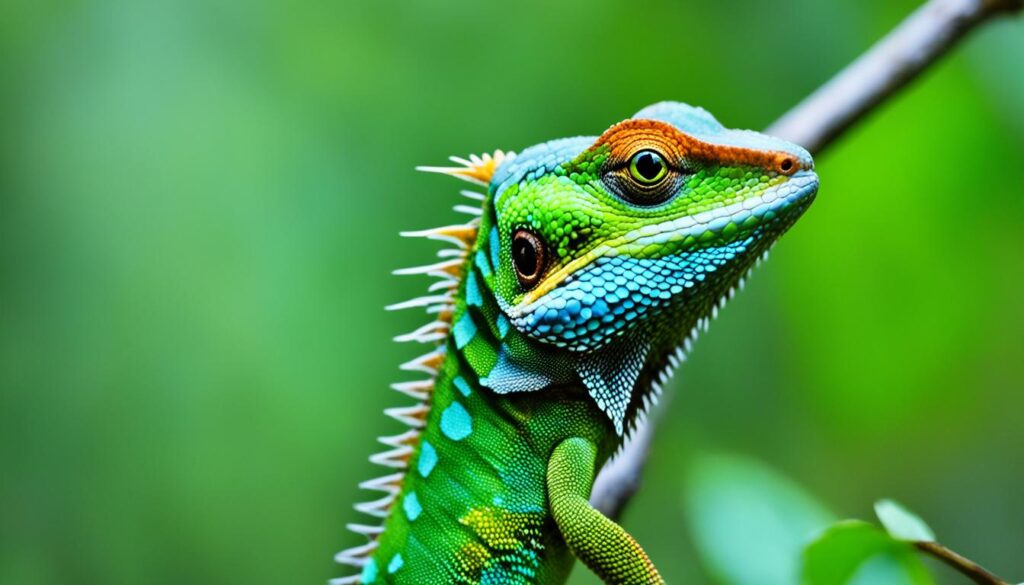
Plumed Basilisk Lizard
The plumed basilisk lizard, also known as the green basilisk or Jesus Christ lizard, is a remarkable reptile found throughout Central America. Its vibrant green coloration makes it blend seamlessly with the lush vegetation of its habitat.
What sets the plumed basilisk lizard apart is its remarkable ability to run across water, a phenomenon that earned it the nickname “Jesus Christ lizard.” It achieves this feat by using its webbed feet and rapid stride, allowing it to stay on the water’s surface without sinking.
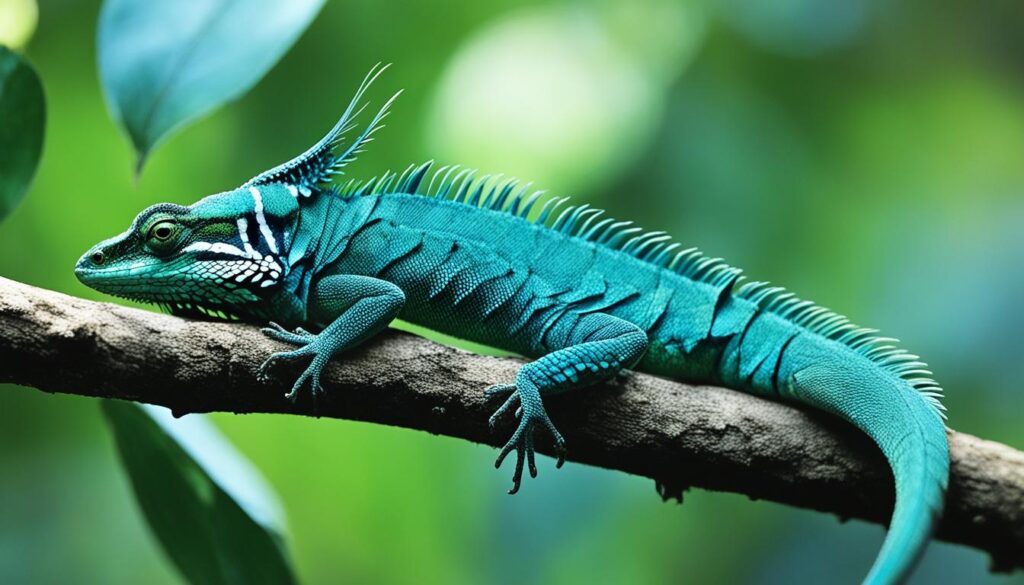
These lizards are primarily found near streams, rivers, and other bodies of water, where they bask in the sunlight and search for prey. The plumed basilisk lizard is an omnivorous creature, feeding on a variety of invertebrates as well as vegetation such as insects, worms, leaves, flowers, and fruits.
Characteristics of Plumed Basilisk Lizard:
| Common Name | Plumed Basilisk Lizard |
|---|---|
| Scientific Name | Basiliscus plumifrons |
| Family | Corytophanidae |
| Habitat | Tropical rainforests and forested areas near water sources |
| Size | Up to 2 feet long, with the tail contributing to a significant portion of the length |
| Coloration | Vibrant green with some brown and yellow markings |
| Behavior | Diurnal, territorial, and excellent climbers |
“The plumed basilisk lizard’s ability to run on water is an incredible adaptation that allows it to escape from predators and efficiently navigate its surroundings. It is truly a marvel of the natural world.” – Dr. Maria Gonzalez, Herpetologist
These lizards are known for their territorial behavior, often defending their territory from intruders, including other plumed basilisks. Males can also display impressive territorial displays by extending their frilled crest, signaling dominance to rival males.
With its captivating green color, impressive water running abilities, and unique behaviors, the plumed basilisk lizard is a fascinating creature that showcases the diversity and adaptability of reptiles in Central America.
Conclusion
Discovering the world of green animals unveils the vibrant hues and breathtaking beauty of the natural world. From the Amazon parrot’s brilliant plumage to the leaf insect’s incredible camouflage, these fascinating creatures showcase the wonders of the green spectrum. Whether soaring through the tropical forests, crawling across the forest floor, or blending into lush foliage, green animals captivate our imagination.
These green creatures can be found in different parts of the world, each species uniquely adapted to their environment. Birds like the resplendent quetzal and the male eclectus parrot enchant us with their vivid green feathers, while the Eastern green mamba and emerald tree boa slither through the jungles with elegance and stealth. Insects such as the praying mantis and the leaf insect are masters of disguise, imitating leaves to hide from predators.
Exploring the diversity of green animals not only expands our knowledge but also deepens our appreciation for the magnificent natural world. Their green coloration is more than just a hue; it is a testament to the adaptability, survival strategies, and unique characteristics of each species. By studying and protecting these green animals, we contribute to the preservation of their habitats and the delicate balance of our planet’s ecosystems.
So let the vibrant green hues of these remarkable creatures inspire us to cherish and conserve the wonders of nature. As we continue to delve into the mysteries of the natural world, there is no doubt that green animals will continue to fascinate and amaze us with their captivating beauty.
